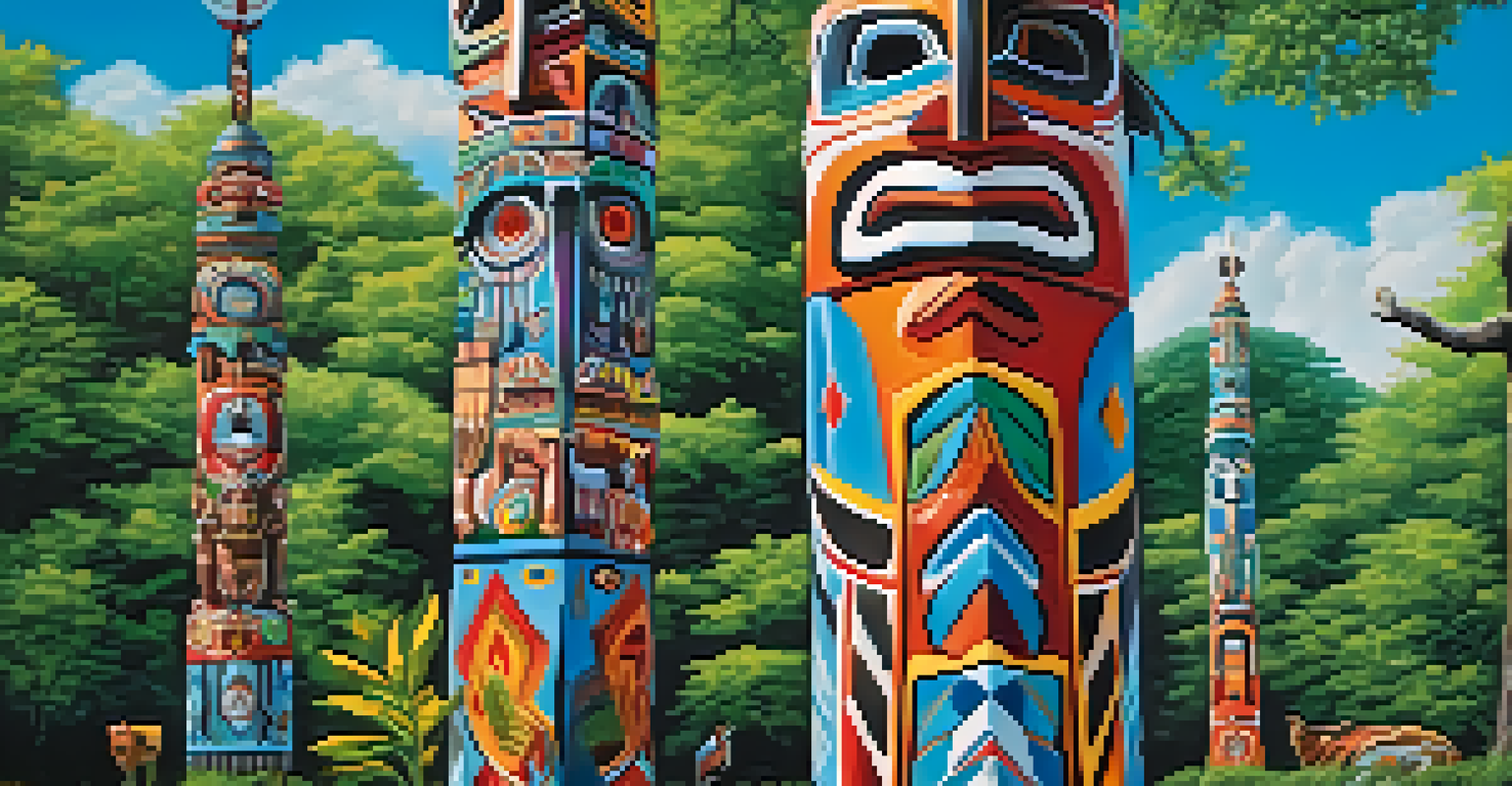Carving as Storytelling: The Cultural Heritage Connection

Understanding Carving as a Form of Storytelling
Carving is more than just shaping wood or stone; it's a way to tell stories that resonate through generations. Each curve and detail can convey emotions, histories, and beliefs. Just like a well-told tale, a carved piece invites the viewer to explore its layers and meanings.
Art is the most beautiful of all lies.
Think of a Native American totem pole; each figure tells a part of a tribal story, representing ancestors, events, or spiritual beliefs. Similarly, African masks often embody the spirit of a community or a significant cultural event. These carvings are not just art; they are narratives etched in material.
By examining these carvings, we can connect with the cultures they represent, allowing us to appreciate their complexities and the storytellers behind them. Through carving, artists share their identities and the essence of their communities, making it a vital form of storytelling.
The Historical Significance of Carving
The practice of carving dates back to ancient civilizations, serving both functional and decorative purposes. Early humans carved symbols into cave walls, creating visual narratives of their lives and environment. This foundational act of storytelling through carving has evolved but remains a crucial aspect of cultural expression.

For example, the intricate carvings found in ancient Egyptian tombs not only adorned the walls but also depicted stories of the afterlife and the pharaohs' journeys. Similarly, the Maori of New Zealand use carving to tell their whakapapa, or genealogy, preserving their history and values through wood and bone.
Carving as Cultural Storytelling
Carving serves as a powerful medium for expressing cultural narratives and identities through intricate designs and symbols.
This historical context reveals that carving is not merely an artistic endeavor; it's a testament to human creativity and the need to communicate experiences. These carved stories endure, allowing us to glimpse into the past and understand the beliefs of those who came before us.
Cultural Identity and Carving
Carving plays a pivotal role in expressing cultural identity, often reflecting the values, beliefs, and experiences of a community. In many cultures, specific motifs or styles are unique to their heritage, making each carving a symbol of pride and belonging. This connection to identity is crucial, especially in a rapidly globalizing world.
Every piece of art is a story waiting to be told.
Take the example of Inuit carvings, which often depict animals and nature, highlighting the deep relationship between the Inuit people and their environment. These carvings not only showcase artistic skill but also convey a deep respect for nature and the stories tied to their survival.
Through carving, communities can preserve their unique narratives while also educating outsiders about their culture. As these stories are shared, they foster understanding and appreciation, reinforcing cultural identity in an increasingly interconnected world.
Techniques and Styles Across Cultures
Carving techniques vary significantly between cultures, each with its distinct tools and methods. For instance, Japanese woodblock printing, known as ukiyo-e, combines carving with printing, creating beautiful images that tell stories of landscapes and daily life. In contrast, the intricate stone carvings of Indian temples depict deities and mythological tales, often requiring highly skilled craftsmanship.
These differences highlight the diversity of storytelling methods through carving. While the materials may differ—wood, stone, or bone—the intent remains the same: to communicate messages and preserve cultural narratives.
Emotional Connections in Carving
Carved artworks evoke deep emotions, allowing individuals to connect personally with the stories and experiences they represent.
As artists learn from one another and adapt techniques, they create new styles that blend influences, further enriching the tapestry of storytelling through carving. This evolution of techniques showcases the dynamic nature of cultural expression and its ability to adapt while retaining core messages.
The Emotional Impact of Carved Stories
Carvings can evoke powerful emotions, transcending language barriers and connecting people on a deeper level. A beautifully carved piece can resonate with viewers, stirring feelings of nostalgia, joy, or even sorrow. This emotional impact is a vital aspect of storytelling, as it allows individuals to relate personally to the narratives being conveyed.
Consider a carved statue representing a beloved community leader; it may inspire pride and remembrance among locals. Similarly, a sculpture depicting a historical event can provoke reflection and understanding of shared struggles and triumphs.
These emotional connections reinforce the idea that carving is not just an art form but a shared experience that resonates within communities. Through these carved stories, artists create lasting impressions that foster empathy and connection among diverse audiences.
The Role of Carving in Modern Society
In today's world, carving continues to be a relevant medium for storytelling, adapting to contemporary themes. Artists are now using carving to comment on social issues, environmental concerns, and personal narratives, bridging the gap between tradition and modernity. This evolution showcases the adaptability and relevance of carving as a storytelling form.
For example, modern sculptors might incorporate recycled materials into their work, telling stories about sustainability and the impact of consumerism. This approach not only honors traditional techniques but also addresses pressing issues that resonate with today's audiences.
Preserving Carving Traditions
Maintaining carving traditions is vital for passing down cultural heritage and fostering a sense of identity in future generations.
By finding new ways to tell stories through carving, artists ensure that this ancient practice remains vibrant and meaningful. As they weave current themes into their work, they invite audiences to engage with their narratives and foster dialogue about important cultural and social topics.
Preserving Carving Traditions for Future Generations
As we navigate a fast-paced world, it's essential to preserve carving traditions for future generations. These practices hold invaluable knowledge and stories that define cultural heritage and identity. By teaching young artists the techniques and significance of carving, we ensure that these narratives continue to be told.
Cultural organizations and artists are increasingly offering workshops and educational programs to share these skills. Through hands-on experiences, participants can connect with their heritage and learn the stories behind the carvings, fostering a deeper appreciation for their culture.

Preserving these traditions not only honors the past but also encourages a sense of belonging and identity in younger generations. As they carry forward these stories through their own carving practices, they contribute to an ongoing legacy of storytelling that enriches our shared cultural tapestry.